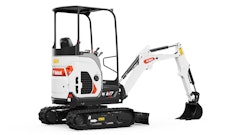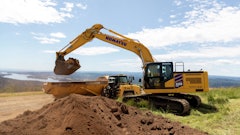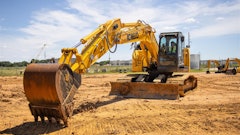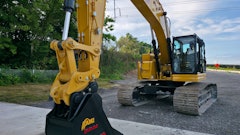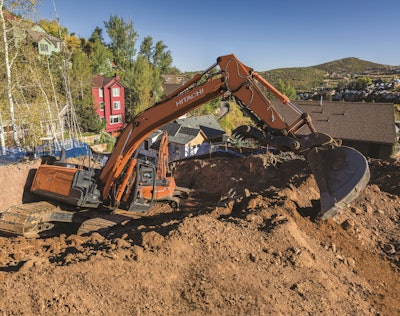
When properly equipped and run by skilled operators, excavators are excellent tools to complete work on slopes. But this type of work does require attention to detail not required when working on flat ground.
“An excavator is capable of climbing some pretty steep slopes,” says Matt Hendry, product specialist, Hitachi and John Deere excavators. “When working on slopes, it takes a lot of extra care.”
Take a look at the video below for a quick rundown of 11 safety tips and continue reading the full article for a more in-depth analysis of safe excavator operation on slopes.
First, you need to carefully assess the jobsite and the work to be performed. “There is no way to foresee all the things that can go wrong while working in and around a slope,” says George Lumpkins, national service manager, Kobelco Construction Machinery USA. “The operator must assess the situation carefully on a case-by-case basis, and is responsible for the safety of himself or herself, the machine, surrounding equipment and the surrounding people.”
There are too many scenarios to cover in a single article, but the following provides a few tips.
Depending on the severity of the slope, traction will be a concern. Even with tracks, there is only so much traction available.
“Ground-to-track shoe traction is the limiting factor for safe operation,” says Lumpkins. “If you cannot dig parallel to the tracks, pointed downhill, and not slide the machine toward the bucket, the slope and ground condition are too steep for safe untethered operation.”
Orientation of the tracks is critical for safe operation. “If you are working on a slope, you want to be sure the tracks are pointed up and down,” advises Hendry. “Getting sideways on a steep slope can get real interesting in a hurry. If you are working uphill, you want the idlers forward. If you are working downhill, you want the idlers pointed down slope. The drive motors are heavier, so you want more weight behind you. The idlers are designed to take the digging forces of the machine and spread it through the frame via the through axles connected at both points. The drive motors are connected to one side of the frame. So the load factor, on a regular basis, [should be] over the idlers.”
Assume the Correct Position
Similarly, when you are moving the excavator, always make sure the tracks are pointed downhill and use the weight of the attachment to your advantage.
“Going uphill, keeping the attachment out and forward will better balance the machine and aid traction and stability,” says Lumpkins. “Keep the attachment low to the ground. Never travel up or down a slope with the attachment folded in and up. Dangerous loss of rearward stability will result and a rear rollover is very possible. As you crest the slope, slowly raise the bucket and boom to clear the ground as the machine comes over the top, but no more or you will tip the machine backwards.”
Boom and attachment position can help mitigate stability issues when descending a slope. “Going downhill, roll the arm perpendicular to the boom or slightly out, level the bucket, keep the bucket just off the ground, but not dragging, and point the attachment downhill. This will aid quick reaction to control the machine if it begins to slide,” says Lumpkins. “Never back down a slope as you need the attachment in front in case the machine slides.”
Negotiating drop-offs requires operator expertise. “If the slope begins with a sharp edge, the boom and bucket may be lowered over the side to control the machine and prevent a quick tip over the edge,” says Lumpkins. “The attachment can then slowly lower the machine to the slope.”
When traveling uphill, boom and arm position can also help. “If it is steep enough, my preferred method of doing that is to stretch out the arm and keep the boom down low to the slope,” says Hendry. “Stretch the bucket and boom out and get the weight of the bucket and weight of the boom well forward of the machine, then walk your way up. Sometimes you have to put the bucket teeth in the ground and use the arm to help pull you up. That is a good place to be ready to get your teeth sunk in the ground if it starts to slide. You can utilize the bucket and the teeth to stop you from moving and actually help pull you up the slope.”
Pulling the machine up the slope with the boom and arm requires coordination. “While it is possible to use the attachment to pull the machine up a slope, if the tracks are slipping due to a loss of traction, be aware that when you... move the attachment back out for another pull, the machine could slide backwards,” Lumpkins points out. “It helps, but is no guarantee, if you stop the travel function before lifting the bucket. This gives the tracks a better grip than they have moving and sliding on the slippery ground.”
Don’t try to power up the slope with the travel motors while re-positioning the boom and arm. “When you re-position, actually stop your forward motion and then gently re-position,” advises Hendry. “You are apt to slide a little bit, especially if you have triple bar grousers. It takes a really skilled operator and you just have to be cautious. It is not someplace you want to send a new guy. It takes coordination and thinking your way through it. You are using your feet to travel with, to run the travel motors, and you are using your hands.”
Keep the machine steady as you traverse a slope. “Do not swing the machine while traveling on a slope or loss of traction for one track could result,” says Lumpkins.
If you have to dig a trench while on a slope, be aware of the boom and arm position. “When you go to swing, you want to have the boom and arm in fairly close to the machine,” says Hendry. “When you come out of the hole, you want to bring the mast in toward the machine so the swing torque will allow the machine to swing. If you are stretched all of the way out, the momentum to swing is pretty significant. So bring the boom and arm in and pull the mast toward the swing bearing. That will assist the machine in swinging.”
Caution needs to be taken when swinging downhill. “When you are swinging downhill, you want to be very gentle on the swing motor. When you come off that motor with a full bucket, the swing brake is going to work; but if you have too much momentum, it is going to want to try and go all the way back round,” Hendry explains. “It is going to continue swinging downhill against that swing brake. Don’t get too far out with the bucket; pull it in. Swing gently so the swing brake can do its job. If it is a big enough bucket and heavy enough material, and you are too far out on the arm, the momentum and that weight will overcome the swing brake.”
Operators really need to develop a feel for the controls when digging on a slope. “When you are on a hill, adjust how much effort you are putting into the controls,” says Hendry. “When you get off level, an operator can get into trouble very quickly if he doesn’t understand how to do it or hasn’t done it. An unskilled or new operator can get into trouble in a hurry.”
As you transition to working on slopes, the importance of simple safety devices, such as the seat belt, are amplified. “Modern excavators are equipped with ROPS operator’s cabs,” says Lumpkins. “These are of limited use if the operator does not use the seat belt. Seat belts on a slope also aid in machine control, as the operator does not have to fight the angle and gravity to sit in the operator’s seat.”
Observe Physical Limitations
There are physical limitations on the slope due to the typical engine configuration.
“Generally, an excavator should not be operated beyond a 70% slope due to engine lubrication requirements,” says Lumpkins. “Some deep oil pans might allow engine lubrication at greater angles, but you are needlessly risking not only the engine lubrication issue, but traction to the ground.”
This situation is not unique to any particular manufacturer. “Pretty much every engine in the industry is limited to a 30° or 70% slope for lubrication of the engine,” says Hendry. “If you look at the spec sheets of pretty much everybody’s excavator across the board, the engine is limited to that gradation.
“Make sure you are not exceeding that for long periods of time,” he advises. “If you have a short duration where you climb a 1:1 slope, that is typically not bad. But if you are on that steep of a slope too long, you have to take precautions to protect the engine. You can take them on much more severe slopes if you equip the excavator properly. That would be done through the dealer and, in our case, the Deere Technical Assistance Group would provide their recommendations.”
A key limitation is the depth of the sump. “You only have so much depth in the sump, so there is only so much oil. When you are on the severe slopes, it is hard for the engine to pump that oil to the very top of the motor,” explains Hendry. “This results in starvation to the top of the engine.” Be aware that continually operating on steep slopes can reduce engine life expectancy.
Configure Excavators to the Job
With traction being a primary limitation, every effort should be taken to maximize the traction available. “If the customer is generally working on a slope, then single grouser pads should be strongly considered for traction and safety,” says Lumpkins.
Single bar grousers result in much better traction on the slope. “The single bar grouser is like a dozer track,” says Hendry. It penetrates for traction and will help hold the excavator on the slope. “Triple bar grousers are good for flat and reasonable slopes. But as you get into the 1:1 and sometimes steeper [slopes], they will slide when you start trying to work.”
Pipeline contractors who work on steep slopes often “yo-yo” the excavator. “Once they get into that 1:1 category, that is typically where they are trying to yo-yo the machine if they are going to be doing it for any length of time. They will connect the excavator to a cable dozer or two and suspend it below,” says Hendry. This requires some safety modifications to do it properly. “They install a five-point harness for the operator. Sometimes they put pedals or a pad up on the posts of the cab so the operator can put his feet up there to hold himself in the seat. But that is a very severe application.”
It also requires a safe place to attach cables to the excavator. “A lower frame-mounted tow hook or loop would be useful to help secure the machine to a dozer or similar machine while working on a slope,” says Lumpkins. “Do not sling around the lower structures. Too many sharp edges can damage structures.”
Factor in the strength of the rope supporting the excavator, as well as the security of the mounting position (anchor point) on the other end of the wire rope, such as to the front-mounted winch of a dozer with a blade buried in the ground or rear winch with the tracks buried in the ground. “Do not tie to a tree,” cautions Lumpkins. “The power of modern equipment is almost hard to comprehend and tying to a tree of unknown structure is not safe.”
Make use of any options, such as dozer blades. “If the excavator is equipped with a front-mounted dozer, use it,” says Lumpkins. “Use it pointed downhill and pushed into the ground for grip against slipping. Do not raise and operate the machine up on the dozer structures. This is hard on the dozer linkage and reduces the traction of the track shoes.”



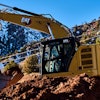
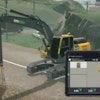
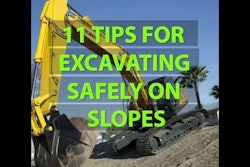

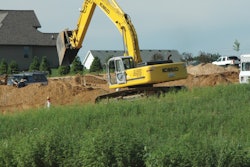






![Hcm Ax Landcros Dual Branded Logo[25]](https://img.forconstructionpros.com/mindful/acbm/workspaces/default/uploads/2025/11/hcmaxlandcros-dual-branded-logo25.Qhg3vUCjoK.jpg?ar=16%3A9&auto=format%2Ccompress&bg=fff&fill-color=fff&fit=fill&h=135&q=70&w=240)
